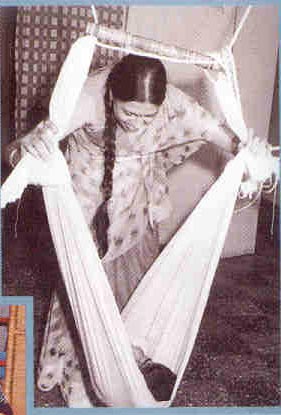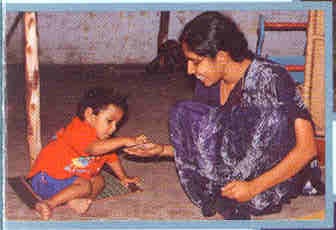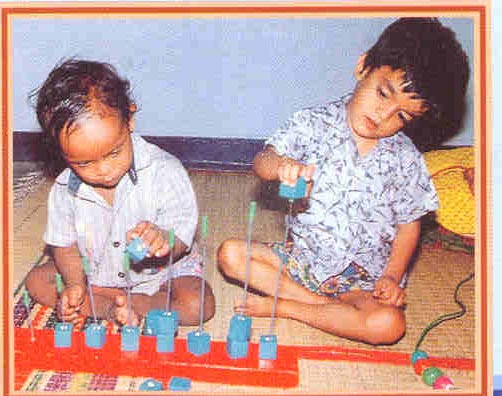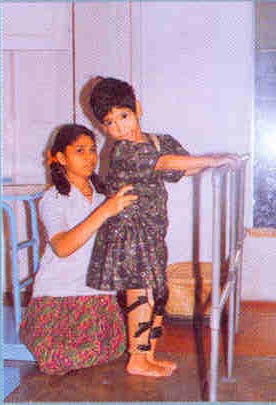



 |
 |
 |
 |
1.1.01 The Upanayan Check List : This list covers broadly the five areas of development and is arranged in the normal developmental sequence of a child. It comprises a total of 250 skills as indicated below. The complete check lists can be seen by clicking on the links below :
This check list is used to assess the child as to the skills he performs and those he is yet to perform. The complete check list is provuded in Annexure I of the hard copy of this presentation.
1.1.02 The Activity Cards : These are in five parts, one part for each of the five development at areas mentioned in para 1.1.01 above.
For easy identification, cards of the different
areas are coloured differently.
These cards contain
-Step by step instructions to carry out various activities to train the
child to acquire
the required skills listed in the checklist.
- Illustrations of the child/the teacher performing the activities.
- A list of materials required for each activity.
A specimen of a typical Activity Card is given at Aooexure- II of the hard copy of this presentation.
Along with Activity Cards on Self-Help, a set of cards giving the linkages to the pre-requisite skills relating to each of the skills in that area are provided. A list of these 'Skill Links is given in Annexure-III of the hard copy of this presentation.
1.1.03 Materails for Assessment and Training : consist of easily available toys and other materials for use in the assessment and the training of the child.
1.1,04 The
Computer programme is an optional item of
the package. It is intended to assist the training programme. A personal
computer (PC-XT) is required for using this programme. Further information
on this is given in Para 3.0.
2.1.1 The
followIng forms and records are used in the apphcation of the programme:
.
01 Background InformatIon Form
02. Assessment Record
03. Daily Observation Record
2.1.2 The Background
Information Form is for recording the following information
about the child :
01. Identification Particulars
02. Family History
03. Medical History
04. Developmental History
05. Emergency InformatIon
This form is to be completed before assessing
the child. A copy of this form is given
in Annexure-IV of the hard copy of
this presentation.
2.1.3 The Assessment Record Form :
It is a format for recording the assessment of the child. The
following identifying information on the child is also to be recorded in
the form :
- Child's name/date of birth, age at entry
- Dates of assessment/names of assessors/co-ordinator.
The assessment recorded indicates visually
the developmental profile of the child. A
sample of a completed Assessment Record Form is given in Auexure V of the
hard copy
of this presentation..
2.1.4 The Daily Observation Record is for recording by parent/teacher of salient observations made by her in the course of the training of the child.
2.2 Note : Read the instructions carefully before applying the programme.
2.3 Have a copy
of each of the following :-
01. Background Information Form
02. Assessment Record
2.4 Complete the Background Information Form, entering all required details concerning the child.
2.5 Keep
ready the necessary materials required for assessment and training.
A list of these materials is given Annexure
VI of the hard copy of this presentation.
Note that there are five periodical assessments
to be recorded in the Assessment Record Form.
01. Initial, at the point of entry (to the training institution)
02. At the end of the first quarter (3 months)
03. At the end of the second quarter (6 months)
04. At the end of the third quarter (9 months)
05. At the end of the fourth quarter (Annual)
The last assessment of the year is to be taken
as the starting point for the next year's training programme.
2.5.1 Enter in the Assessment Record Form the necessary details regarding child's name, date of birth, age at entry point and date of assessment in the space provided for these. Enter the name of the observer/assessor.
2.5.2 Make the
child as comfortable as possible.
You as the trainer should also be relaxed
and comfortable.
Do not rush through the assessment.
Keep ready all the assessment materials.
2.5.3 Using the checklist, begin the assessment of the child in each developmental area, one after the other.
2.5.4 Check sequentially, skill by skill, beginning with the first skill in each area, irrespective of the age of the child.
2.5.5 Give as much time as is necessary for your observations on the child and then record them .
2.5.6 Observe the child's behaviour directly and record responses. Where observations are not directly possible (in the absence of the mother) accept those of anyone else close to the child as valid.
2.5.7 Note
2.5.7.1 Do not
interpret the statements (of skills) by attaching any more meaning to them
than what is stated.
2.5.7.2 Do not
guide or give assistance to child unless the statement specifies so .
2.5.8 Enter A
against the relevant skill number in the column provided in the Assesment
Record Form,
- if the child performs the skill as stated or
-if you are sure that the child does not need any additional training in
the
particular skill.
Enter B against the relevant skill number in the Form.
- if the child does not perform the skill as stated or
- if additional training is required to make him perform it.
2.5.9 After assessing
the child in all the five developmental areas, total the As and Bs and
enter the totals in the relevant columns in the Form.
2.5.10 Note :
2.5.10.1 The
assessment you have now made will give the developmental status of the
child. The information collected is
for use by you, the mother, the trainer or any professional working with
the child as mentioned in the succeeding portion of the manual.
2.6 Setting Goals and Objiectives
2.6.1 Note
2.6.1.1 The "Goals"
in this context refer to the five developmental areas viz Motor, Self-Help,
Language, Cognition and Socialization which you
would select for training the child.
Thc "Objectives" refer to the skills you would
choose for training in each selected
developmental area.
2.6.2 Refer to the Background Information Form. Check up the status of the child regarding his physical health and home environment for deciding on the goals and objectives.
2.6.3 Set your 'objectives' from the five goal areas for the next three months, beginning at the base line (as per initial assessment). While doing so keep in mind the child's age, his physical capacity and his developmental needs.
2.6.4 Set at least one 'objective' in each goal area.
2.7 Activities :
2.7.1 After you have set your 'objectives', pick out the relevant UPANAYAN ACI'IVITY CARDS for the selected skills.
2.7.2 Read the
activities listed for each skill.
` Refer
to the illustrations whenever required.
Activate the child to perform the required skill.
Note every response of the child
Repeat the activity and motivate child by rewarding/appreciating him.
2.7.3 Impart training
as a part of the daily activities of the child --- in his feeding, grooming,
toileting and sleeping schedule. Train child in each activity several times
till he succeeds.
Do not be satisfied with a one time success.
Repeat training till you are sure that the child has acquired the skill.
Recognise and reward any achievement of child.
2.7.4 Note that in the Self-Help area the linkages to the pre-requisite skills in the other areas are given. If the child does not perform a selected Self-Help skill, train him on the pre- requisite skills shown under the Skill Links.
2.8 Daily Observations
2..8.1 Maintain
a daily record of your observations on the responses of the child in the
Dai/y Observation Book.
Date your entries.
2.8.2 Observe
responses carefully and record your observations precisely and briefly.
3.0 COMPUTER AIDED PROGRAMME
3.1 Note on the programme -
3.1.1 The programme operates on a persanal computer. The computer stores ail the information which is on the Upanayan Cards. The 'monitor' (which is similar to a televison picture tube) associated with the computer, displays the information and instructions on activities as selected by you. This selection is made through a 'keyboard' which is similar to a type-writer keyboard. In the case of Self-Help Skills the computer will present on the monitor, the linked skills when you require these.
3.1.2 The c(omputer programme is to be used only after the setting of goals and objectives as explained in Para 2.6 above. The purpose of this programme is to have the computer to assist you in imparting training as explained in Para 2.7.0 (Activities).
3.1.3 You will receive a short familiarisation training before you start using the computer for the UPANAYAN programme.
3.2 Operation of computer aided programme
3.2.1 The monitor will display a list of the five 'areas' and indicate the keys to be pressed to select each area. Select the desired area. You will see a list of skills in that area. Select .the desired skills by pressing the appropriate key. The instructions on the, 'activity' will be displayed on the screen along with relevant pictures. Read and understand these instructions and peoceed with training as explained in Para 2.7 above.
3.2.2 On completion
of training, hand over the computer to the person in charge
of it.
4.0 Concluding Note :
4.1.1 Training the child to overcome the developmental lag is not a one-time task. It is a continuous process, it is a part of the child's daily life. Results may be achieved within the anticipated time or sometimes even earlier. In some children it may take a longer time if there is a set back in their health. Constant reinforcement is necessary. Training should be a pleasant and a participative activity for both the trainer and the child. We are dealing with human beings. Hence the need for a human approach.
4.2 Do not
underestimate the child's potential. One can visualize progress of the
child's development at every stage of training. Remember, the child is
always an active participant. The trainer,
the mother, is always the best motivator.